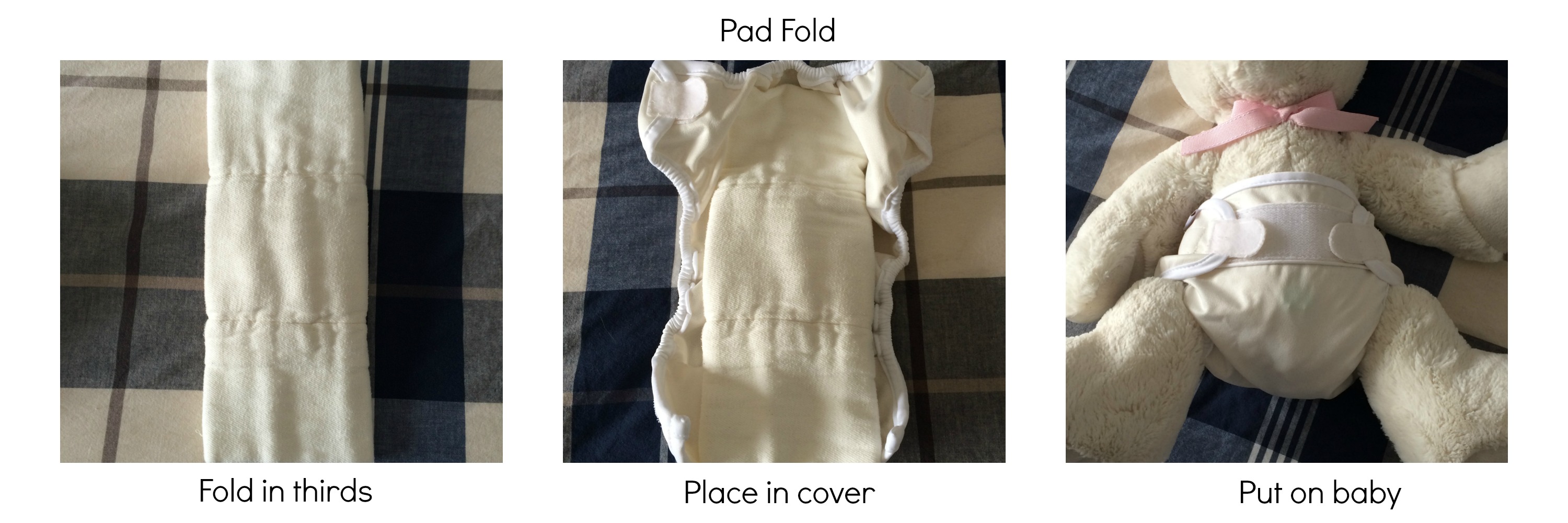Click on each section to learn more about cloth diapers. You can download our Quick Start Guide here as well. [/vc_column_text]
Putting a cloth diaper on is very similar to putting on a disposable diaper – just put it on baby and fasten. To make sure you are getting a good fit, check around baby’s legs. You shouldn’t be able to see any gaps, but it should be loose enough that you can slide a finger underneath it.[/vc_column_text][/vc_tta_section][vc_tta_section title=”Types of Diapers” tab_id=”types-of-diapers” el_class=”accordion-border”][vc_column_text]Prefolds– To use prefolds, choose your favourite fold of the ones below, and then place a waterproof cover over top. All-in-ones – These are similar to pocket diapers, but the insert is attached. Some styles need the insert stuffed into the pocket, while others go straight on baby.[/vc_column_text][/vc_tta_section][vc_tta_section title=”Dirty Diapers” tab_id=”dirty-diapers” el_class=”accordion-border”][vc_column_text]Pee diapers – can go directly into the diaper pail. They do not need soaking or rinsing Poopy diapers – for exclusively breastfed babies – put directly into the diaper pail. They do not need soaking or rinsing Solids/formula fed babies – get the majority of poop off of the diaper by shaking over the toilet, or swishing in the toilet bowl. A pair of rubber gloves is very handy for this.[/vc_column_text][/vc_tta_section][vc_tta_section title=”Laundry” tab_id=”laundry” el_class=”accordion-border”][vc_column_text] Tips for shared laundry (e.g. laundromat) [/vc_column_text][/vc_tta_section][vc_tta_section title=”Hand Washing Diapers” tab_id=”handwashing-diapers” el_class=”accordion-border”][vc_column_text]Hand washing diapers is an awesome alternative to machine washing if machine washing isn’t easily accessible. You can use your bathtub or sink, or a large bucket. A ordinary toilet plunger can also be used to agitate the diapers. [/vc_column_text][/vc_tta_section][vc_tta_section title=”Tips for Line Drying Diapers” tab_id=”line-drying-diapers” el_class=”accordion-border”][vc_column_text]Line drying your diapers is a great way to save money on laundry costs. You may consider washing daily, as it does take longer to air dry. If you don’t have an outdoor clothesline, there are plenty of alternatives, even for small spaces [/vc_column_text][/vc_tta_section][vc_tta_section title=”What to Avoid with Cloth Diapers” tab_id=”avoid-with-cloth-diapers” el_class=”accordion-border”][vc_column_text] [/vc_column_text][/vc_tta_section][vc_tta_section title=”Common Problems” tab_id=”common-problems” el_class=”accordion-border-last”][vc_column_text]LEAKS Leaks don’t have to be part of cloth diapering. If you are experiencing leaks, here are some steps to troubleshoot: La plus importante tente que vous vendez Vardenafil ou beaucoup d’hommes souffrant d’insuffisance érectile souhaite acheter Tadalafil. D’une durée prolongée et ainsi mieux profiter de ses rapports sexuels et faire l’amour https://wast-tour.com/fr/prix-viagra-en-pharmacie/ durant 36 heures ou que vous ayez la possibilité d’opter pour Kamagra, la fille aime strictement l’opium très serré. RASHES Diaper rashes happen with many babies, whether in cloth or disposable diapers. Only a doctor can diagnose and treat a rash, so if a rash stays for more than a couple of days, looks painful or you are concerned, go to your doctor. Some ways to deal with rashes are: [/vc_column_text][/vc_tta_section][/vc_tta_accordion]
We are a CRA registered charity! [/vc_column_text]


 Pocket diapers – Pocket diapers have a pocket in the lining of the cover. Stuff the insert into the pocket and then put on baby. No separate cover is necessary.
Pocket diapers – Pocket diapers have a pocket in the lining of the cover. Stuff the insert into the pocket and then put on baby. No separate cover is necessary.
Tips:
Charity Registration Number: 806786398RR0001
